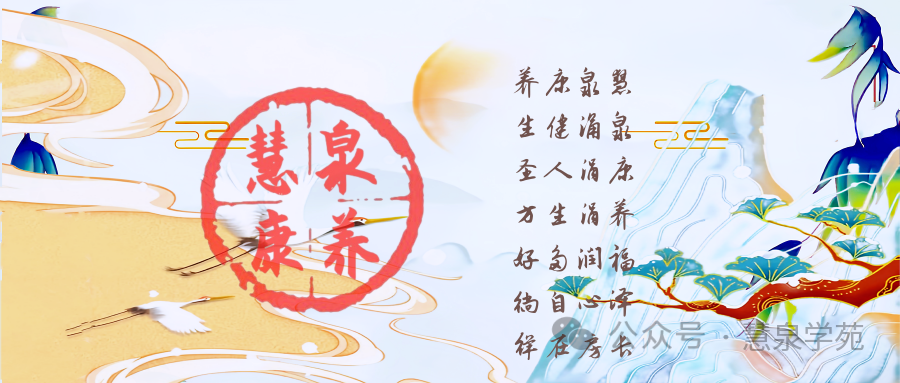

The Huangdi Neijing (Yellow Emperor’s Inner Canon) is an encyclopedic medical work divided into two parts: Ling Shu (Spiritual Pivot) and Su Wen (Plain Questions). It is said to have originated from the legendary Emperor Huangdi and has been passed down orally through generations, later supplemented and developed by physicians and medical theorists, culminating in its compilation during the Spring and Autumn and Warring States periods. It is one of the four classic texts of traditional Chinese medicine (TCM) alongside the Nanjing (Classic of Difficult Issues), Shanghan Lun (Treatise on Cold Damage), and Shennong Bencao Jing (Shennong’s Classic of Materia Medica).
The Huangdi Neijing is based on the theories of Huang-Lao Daoism and presents the establishment of TCM through dialogues and Q&A between the Yellow Emperor, Qi Bo, and Gu Yu. It elaborates on concepts such as Yin and Yang, Five Elements, Pulse Diagnosis, Organ Systems, Pathogenesis, Symptoms, Diagnosis, Treatment Principles, Health Preservation, and Five Movements and Six Qi, discussing medicine from a holistic perspective and presenting a systematic medical model that integrates nature, biology, psychology, and society.
The foundational materials of the Huangdi Neijing stem from the ancient Chinese observations of the universe and life phenomena, extensive clinical practice, and anatomical knowledge of the human body.
The Huangdi Neijing lays the groundwork for understanding human physiology, pathology, diagnosis, and treatment, making it a highly influential medical text in China, often referred to as the “ancestor of medicine.”
Summary
Whenever there are issues with tendons, treat the liver. Whenever there are issues with bones, treat the kidneys. Whenever there are issues with muscles, treat the spleen and stomach. Whenever there are issues with blood vessels, treat the heart. Whenever there are issues with skin and hair, treat the lungs.
Five Organs
1. Heart: The heart is the residence of the spirit, the master of blood, and the source of pulse. It belongs to the fire element; physiological functions include: ① governing blood vessels; ② governing consciousness; the heart opens to the tongue, connects with the pulse, its manifestation is on the face, associated with joy, and its fluid is sweat. The heart is interrelated with the small intestine.2. Lung: The lung is the place of the corporeal soul, the master of qi, belonging to the metal element; physiological functions include: ① governing qi and controlling respiration; ② governing diffusion and descending; ③ regulating water pathways; ④ governing the hundred vessels and treating stagnation; assisting the heart in regulating qi and blood flow; the lung connects to the throat, manifests on the skin, its manifestation is on hair, opens to the nose, associated with worry, and its fluid is mucus. The lung is interrelated with the large intestine.3. Spleen: The spleen is the source of qi and blood transformation, the foundation of postnatal life, housing intention, belonging to the earth element. Physiological functions include: ① governing transformation and transportation; ② governing the elevation of clear qi; ③ governing blood containment; opens to the mouth, connects with flesh, governs the four limbs, its manifestation is on the lips, associated with thought, and its fluid is saliva; the spleen is interrelated with the stomach.4. Liver: The liver is the place of the ethereal soul, the storehouse of blood, and the source of tendons, belonging to the wood element, governing upward movement. Physiological functions include: ① governing smooth flow; ② governing blood storage; opens to the eyes, connects with tendons, its manifestation is on nails, associated with anger, and its fluid is tears; the liver is interrelated with the gallbladder.5. Kidney: The kidney is the root of pre-natal essence, housing will, with the lower back as its organ, belonging to the water element; physiological functions include: ① storing essence, governing growth, development, and reproduction; ② governing water; ③ governing qi intake; in the body, it relates to bones, governs marrow, its manifestation is on hair, opens to the ears and the two yin (anus and perineum), associated with fear, and its fluid is saliva; the kidney is interrelated with the bladder.
Six Bowels
1. Gallbladder: Physiological function: stores and excretes bile, the gallbladder governs decision-making.
2. Stomach: Physiological function: receives and digests food, the stomach descends to harmonize.
3. Small Intestine: Physiological function: governs reception and transformation, separates clear from turbid, “the small intestine governs fluids.”4. Large Intestine: Physiological function: transmits and transforms waste, the large intestine governs fluids.5. Bladder: Physiological function: stores and excretes urine, relying on the kidney’s qi transformation.6. San Jiao: Physiological function: governs the flow of original qi, oversees qi mechanisms and transformations, serving as the pathway for water and fluids.
Dynamic Diagram of the Fourteen Meridians
In a day, there are twelve time periods, each corresponding to a meridian, connecting end to end like a loop. Mastering your body means mastering the secrets of longevity and health!
1. Gallbladder Meridian
Zi Hour: 23:00——1:00
Gallbladder Meridian: Deep sleep! The gallbladder needs metabolism; one must sleep during the Zi hour for the gallbladder to complete its metabolism. At this time, the heart’s function is weakest; if there are heart patients, prepare the heart-saving pill.
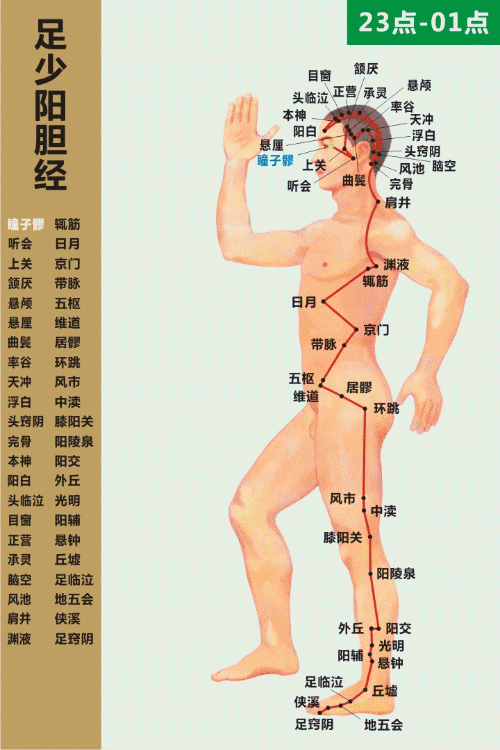 Eliminate diseases, achieve immediate results; to become a general, one must first have gallbladder courage.Relieve mental and physical worries (anger tends to be stored in the liver; if too much is stored and cannot be released, it blocks the gallbladder, leading to gallbladder inflammation and gallstones. Therefore, we must expel the turbid qi; the liver has no direct pathway to the outside world and can only rely on the gallbladder meridian).Symptoms of Gallbladder Meridian Blockage:1. Problems with the gallbladder usually manifest as bile overflow, resulting in a bitter mouth upon waking,2. a grayish appearance on the face,3. frequent migraines, sciatica, or breast-related issues,4. gynecological diseases are also governed by the gallbladder meridian,5. some people experience alternating cold and hot sensations, which is also caused by gallbladder blockage,6. frequent sighing and pain in the ribs are related to gallbladder stagnation.The Foot Shaoyang Gallbladder Meridian is one of the most important meridians in TCM, starting from the pupil point on the face, circling behind the ear, passing through the neck, chest, abdomen, legs, and ending at the little toe.There are 44 acupoints along this meridian, with many located on the face and lower legs. Blockage of the gallbladder meridian can lead to headaches, migraines, tinnitus, breast diseases, gallstones, varicose veins, etc. My circulation occurs from 23:00 to 1:00; the clearer the bile, the clearer the brain. Sleeping at this time with a clear mind and a rosy complexion, tapping the gallbladder meridian in the morning enhances its effects.If symptoms arise, one can use grapefruit, geranium, or juniper to massage the liver and gallbladder meridian. The liver, stomach, and bladder meridians have already been introduced; more exciting content is coming, so don’t miss it!Acupoints on the Gallbladder Meridian:Shoulder and Neck Point: Treats pain, breast diseases, and lymphatic tuberculosis,Yuan Ye Point: Treats breast hyperplasia, intercostal neuralgia, and armpit sweating.
Eliminate diseases, achieve immediate results; to become a general, one must first have gallbladder courage.Relieve mental and physical worries (anger tends to be stored in the liver; if too much is stored and cannot be released, it blocks the gallbladder, leading to gallbladder inflammation and gallstones. Therefore, we must expel the turbid qi; the liver has no direct pathway to the outside world and can only rely on the gallbladder meridian).Symptoms of Gallbladder Meridian Blockage:1. Problems with the gallbladder usually manifest as bile overflow, resulting in a bitter mouth upon waking,2. a grayish appearance on the face,3. frequent migraines, sciatica, or breast-related issues,4. gynecological diseases are also governed by the gallbladder meridian,5. some people experience alternating cold and hot sensations, which is also caused by gallbladder blockage,6. frequent sighing and pain in the ribs are related to gallbladder stagnation.The Foot Shaoyang Gallbladder Meridian is one of the most important meridians in TCM, starting from the pupil point on the face, circling behind the ear, passing through the neck, chest, abdomen, legs, and ending at the little toe.There are 44 acupoints along this meridian, with many located on the face and lower legs. Blockage of the gallbladder meridian can lead to headaches, migraines, tinnitus, breast diseases, gallstones, varicose veins, etc. My circulation occurs from 23:00 to 1:00; the clearer the bile, the clearer the brain. Sleeping at this time with a clear mind and a rosy complexion, tapping the gallbladder meridian in the morning enhances its effects.If symptoms arise, one can use grapefruit, geranium, or juniper to massage the liver and gallbladder meridian. The liver, stomach, and bladder meridians have already been introduced; more exciting content is coming, so don’t miss it!Acupoints on the Gallbladder Meridian:Shoulder and Neck Point: Treats pain, breast diseases, and lymphatic tuberculosis,Yuan Ye Point: Treats breast hyperplasia, intercostal neuralgia, and armpit sweating.
2. Liver Meridian
Chou Hour: 1:00——3:00
Liver Meridian: Deep sleep! This is the best time for liver repair; waste blood needs to be eliminated, and fresh blood needs to be produced during the Chou hour. One must enter a deep sleep state to provide the liver with sufficient energy. If one does not sleep, the liver continues to output energy to support thinking and actions, preventing metabolism from completing, leading to liver disease.
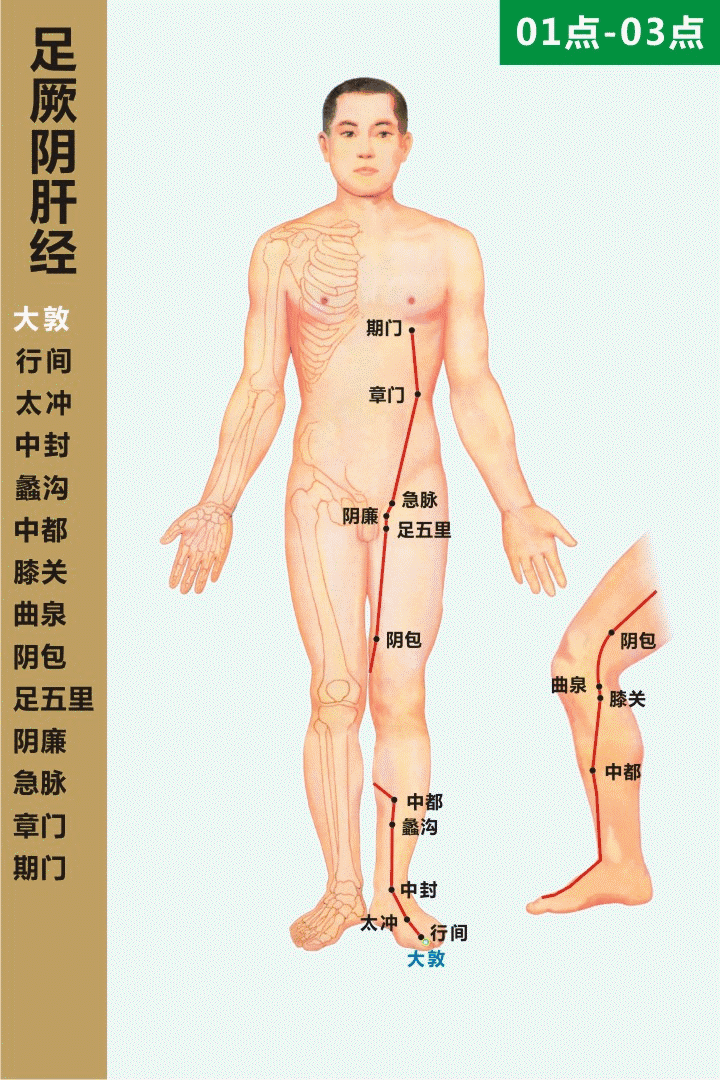 The universal remedy for life (in TCM, all diseases arise from qi; qi originates from the liver, and excessive anger harms the liver, so one should minimize anger; once anger arises, it cannot be contained). Friends, wake up and quickly tap the liver and gallbladder meridian for health. The Foot Jueyin Liver Meridian is one of the most important meridians in the body, starting from the inner side of the big toe and ending at the Da Dun point in the chest, traversing the foot, leg, abdomen, and chest. There are 14 acupoints along this meridian; blockage of the liver meridian can lead to breast hyperplasia, chronic liver disease, menstrual irregularities, and uterine issues.The circulation time is from 1:00 to 3:00; massaging during this period can enhance the functions of the five organs. Essential oils such as sage, chamomile, rosemary, bergamot, and lavender can enhance the massage effects.If there is pain in the ribs, a bitter mouth, toothache, jaw pain, oral ulcers, or nosebleeds, especially if there are blisters on the tongue, it indicates excessive heart fire. At this time, the fire is no longer in the liver, and one should frequently massage the Xing Jian point.All diseases arise from the heart; to eliminate heart disease, one must address liver fire and enhance the liver’s detoxification function. Once the liver’s detoxification function is strengthened, the blood will be purified, preventing high blood lipids. Many chronic diseases manifest in the liver; only by properly managing this detoxification factory can one avoid illness.If one frequently experiences dizziness, weakness, and insufficient heart blood supply, a hospital check may reveal insufficient blood supply to the heart, which actually indicates weakened liver function, as the liver is responsible for supplying qi and blood to the heart, necessitating liver regulation.
The universal remedy for life (in TCM, all diseases arise from qi; qi originates from the liver, and excessive anger harms the liver, so one should minimize anger; once anger arises, it cannot be contained). Friends, wake up and quickly tap the liver and gallbladder meridian for health. The Foot Jueyin Liver Meridian is one of the most important meridians in the body, starting from the inner side of the big toe and ending at the Da Dun point in the chest, traversing the foot, leg, abdomen, and chest. There are 14 acupoints along this meridian; blockage of the liver meridian can lead to breast hyperplasia, chronic liver disease, menstrual irregularities, and uterine issues.The circulation time is from 1:00 to 3:00; massaging during this period can enhance the functions of the five organs. Essential oils such as sage, chamomile, rosemary, bergamot, and lavender can enhance the massage effects.If there is pain in the ribs, a bitter mouth, toothache, jaw pain, oral ulcers, or nosebleeds, especially if there are blisters on the tongue, it indicates excessive heart fire. At this time, the fire is no longer in the liver, and one should frequently massage the Xing Jian point.All diseases arise from the heart; to eliminate heart disease, one must address liver fire and enhance the liver’s detoxification function. Once the liver’s detoxification function is strengthened, the blood will be purified, preventing high blood lipids. Many chronic diseases manifest in the liver; only by properly managing this detoxification factory can one avoid illness.If one frequently experiences dizziness, weakness, and insufficient heart blood supply, a hospital check may reveal insufficient blood supply to the heart, which actually indicates weakened liver function, as the liver is responsible for supplying qi and blood to the heart, necessitating liver regulation.
3. Lung Meridian
Yin Hour: 3:00——5:00
Lung Meridian: The transformation of yin and yang begins at this moment, transitioning from yin to yang. The human body also enters a phase of yang dominance and yin decline. At this moment, the lung meridian is most active. The liver provides blood to the lungs, which then distributes it throughout the body. At this time, the body requires a large amount of oxygen. Patients with lung diseases or asthma should take medication during the Yin hour for better effects than during the day.
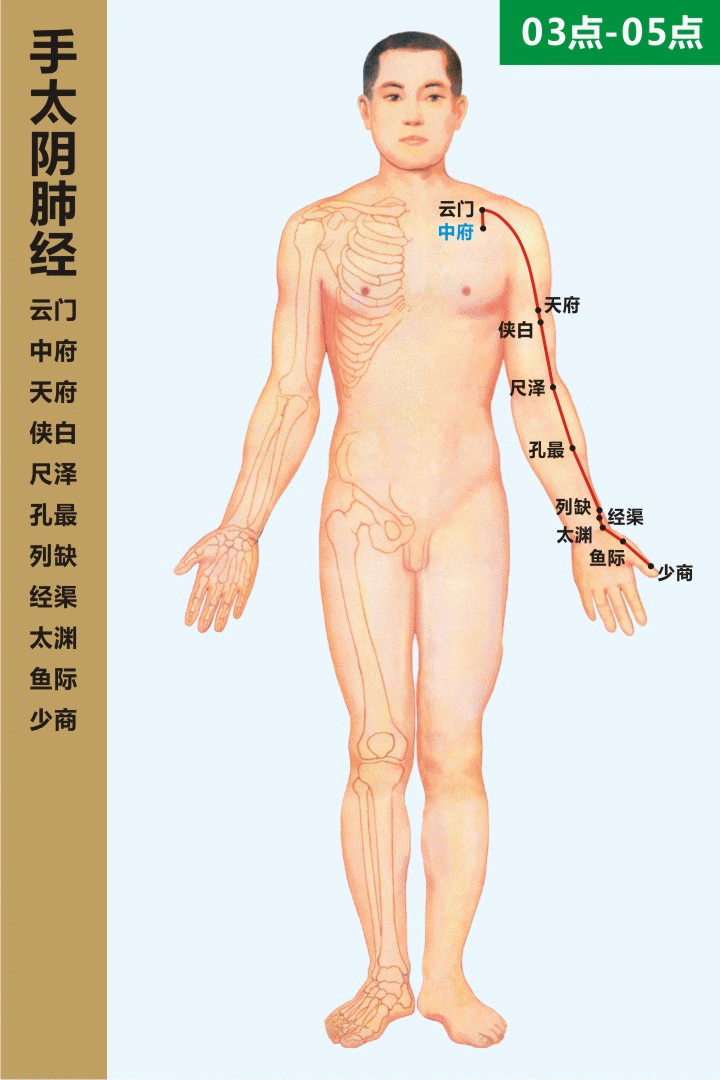 The lung meridian can treat lung-related ailments; the lung opens to the nose, so nasal issues are often related to the lung meridian, as well as throat issues, so throat problems can be resolved through the lung meridian. The primary goal of unblocking the meridian is to expel turbid qi; many people experience burping when massaging the lung meridian, which is a very good phenomenon.Acupoints on the Lung Meridian:Shao Shang Point: Treats acute throat swelling and pain.Yu Ji Point: This is the fire point of the lung meridian, known for its excellent heat-clearing effects.Tai Yuan Point: When lung qi is sufficient, one feels energetic; this point is specifically for tonification, and frequent massage can provide endless energy.
The lung meridian can treat lung-related ailments; the lung opens to the nose, so nasal issues are often related to the lung meridian, as well as throat issues, so throat problems can be resolved through the lung meridian. The primary goal of unblocking the meridian is to expel turbid qi; many people experience burping when massaging the lung meridian, which is a very good phenomenon.Acupoints on the Lung Meridian:Shao Shang Point: Treats acute throat swelling and pain.Yu Ji Point: This is the fire point of the lung meridian, known for its excellent heat-clearing effects.Tai Yuan Point: When lung qi is sufficient, one feels energetic; this point is specifically for tonification, and frequent massage can provide endless energy.
4. Large Intestine Meridian
Mao Hour: 5:00——7:00
Large Intestine Meridian: Bowel movement! Drink a cup of warm water before defecation. This is the time when the large intestine is most active, absorbing moisture and nutrients from food and expelling waste.
 The hand yangming large intestine meridian is the best meridian for treating constipation and diarrhea, starting from the Shang Yang point of the index finger and ending at the Ying Xiang point on the face, traversing the hand, arm, neck, and face, with 20 acupoints along the meridian.Blockage of the large intestine meridian can lead to constipation, diarrhea, gastrointestinal issues, dry and swollen eyes, etc. The circulation time is from 5:00 to 7:00; if one does not defecate during this time, it indicates blockage of the large intestine meridian. Essential oils such as geranium, grapefruit, sweet orange, and lemon can be used for massage to achieve therapeutic and maintenance effects.Acupoints on the Large Intestine Meridian:Ying Xiang Point: Treats rhinitis.
The hand yangming large intestine meridian is the best meridian for treating constipation and diarrhea, starting from the Shang Yang point of the index finger and ending at the Ying Xiang point on the face, traversing the hand, arm, neck, and face, with 20 acupoints along the meridian.Blockage of the large intestine meridian can lead to constipation, diarrhea, gastrointestinal issues, dry and swollen eyes, etc. The circulation time is from 5:00 to 7:00; if one does not defecate during this time, it indicates blockage of the large intestine meridian. Essential oils such as geranium, grapefruit, sweet orange, and lemon can be used for massage to achieve therapeutic and maintenance effects.Acupoints on the Large Intestine Meridian:Ying Xiang Point: Treats rhinitis.
5. Stomach Meridian
Chen Hour: 7:00——9:00
Stomach Meridian: Don’t forget to eat breakfast! At this time, gastric acid is continuously secreted; if one goes hungry for too long, there is a risk of gastric ulcers, gastritis, duodenitis, and cholecystitis!
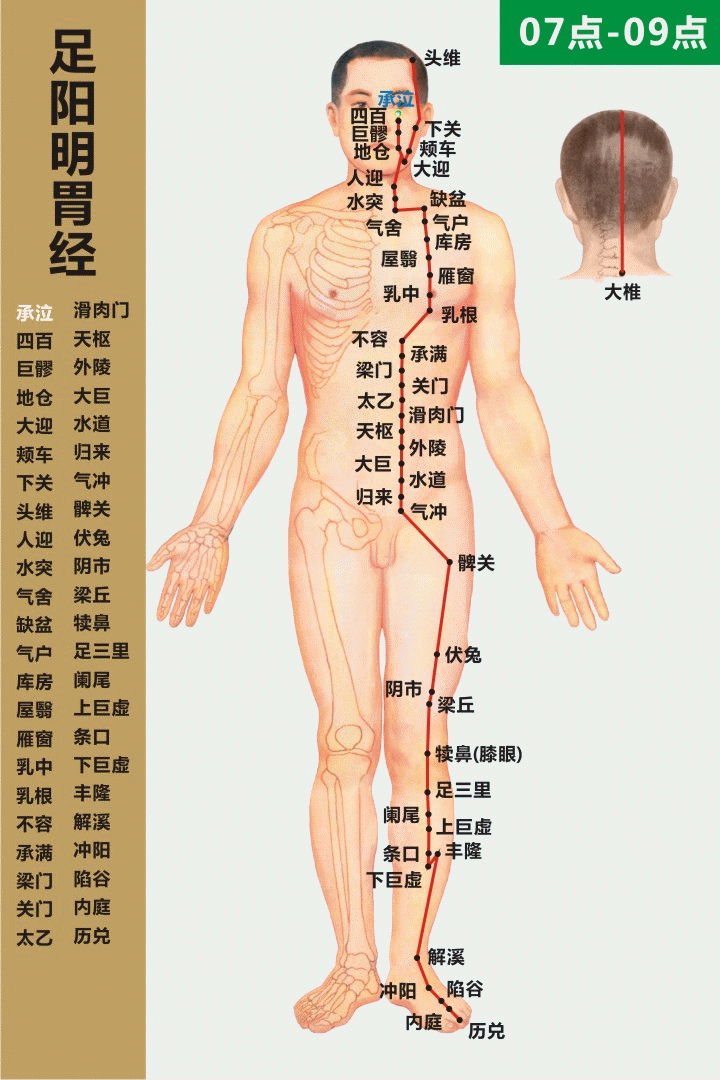 Every day nurtures our postnatal foundation. A smooth stomach meridian allows for restful sleep, good appetite, and a rosy complexion, and can even rejuvenate one’s youth. The stomach meridian manages gastrointestinal function; once gastrointestinal function is disrupted, the entire body becomes weak.The sun shines high, and the stomach meridian brings blessings. The Foot Yangming Stomach Meridian starts from the Cheng Qi point on the face and ends at the Li Dui point on the foot, traversing the face, neck, chest, abdomen, and legs, with a total of 43 acupoints, mostly located in the abdomen and chest. Blockage of the stomach meridian can cause discomfort throughout the meridian’s area; the stomach meridian circulates from 7:00 to 9:00, so we must eat breakfast during this time! If you already have symptoms of stomach meridian blockage, you can use sweet orange, lemon, bergamot, geranium, and sandalwood essential oils for massage.Acupoints on the Stomach Meridian:Cheng Qi: Can quickly relieve tearing when facing the wind, and treat glaucoma.Si Bai: If dark circles appear, or if the eyes feel swollen and sore, persistent massage of this point can resolve many issues.Jia Che: Treats facial nerve paralysis, teeth grinding at night, and jaw clenching; massaging this point has excellent effects.Tip:Walking on a soft bed can help qi and blood flow to the knees, providing lubrication equivalent to oil for the knees, which can treat common ailments in the elderly such as knee pain, leg weakness, and hypertension. For young people, this is a common method for slimming the legs.
Every day nurtures our postnatal foundation. A smooth stomach meridian allows for restful sleep, good appetite, and a rosy complexion, and can even rejuvenate one’s youth. The stomach meridian manages gastrointestinal function; once gastrointestinal function is disrupted, the entire body becomes weak.The sun shines high, and the stomach meridian brings blessings. The Foot Yangming Stomach Meridian starts from the Cheng Qi point on the face and ends at the Li Dui point on the foot, traversing the face, neck, chest, abdomen, and legs, with a total of 43 acupoints, mostly located in the abdomen and chest. Blockage of the stomach meridian can cause discomfort throughout the meridian’s area; the stomach meridian circulates from 7:00 to 9:00, so we must eat breakfast during this time! If you already have symptoms of stomach meridian blockage, you can use sweet orange, lemon, bergamot, geranium, and sandalwood essential oils for massage.Acupoints on the Stomach Meridian:Cheng Qi: Can quickly relieve tearing when facing the wind, and treat glaucoma.Si Bai: If dark circles appear, or if the eyes feel swollen and sore, persistent massage of this point can resolve many issues.Jia Che: Treats facial nerve paralysis, teeth grinding at night, and jaw clenching; massaging this point has excellent effects.Tip:Walking on a soft bed can help qi and blood flow to the knees, providing lubrication equivalent to oil for the knees, which can treat common ailments in the elderly such as knee pain, leg weakness, and hypertension. For young people, this is a common method for slimming the legs.
6. Spleen Meridian
Si Hour: 9:00——11:00
Spleen Meridian: Drink water! (Drink more water at this time) The spleen is the overall coordinator of digestion, absorption, and excretion. The spleen is the foundation of postnatal life. To tonify the spleen: use coix, red beans, and yam porridge. Aim for about 2000ml of water daily, equivalent to 5 bottles of mineral water; keep drinking and avoid any beverages.
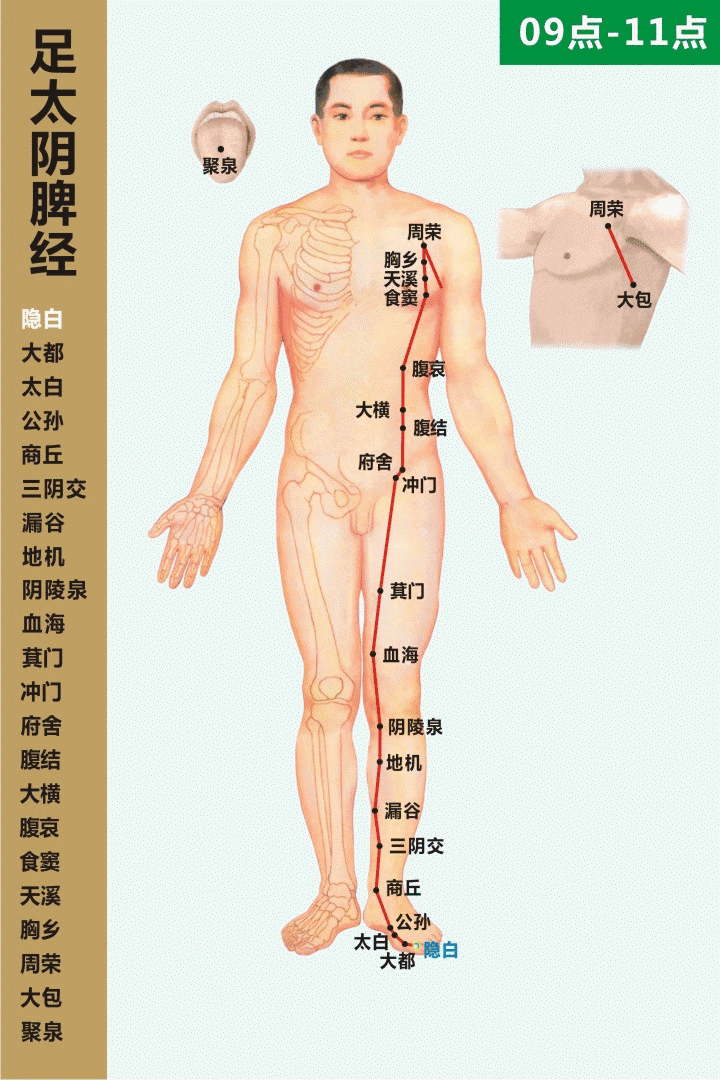 Eliminate any chronic diseases; the foundation of postnatal life and the source of qi and blood transformation. The early bird catches the worm; by waking up early, you can receive health knowledge.The Foot Taiyin Spleen Meridian starts from the Yin Bai point on the big toe and ends at the Da Bao point above the chest, traversing from the foot to the leg, abdomen, and ending at the chest.There are 20 acupoints along this meridian; blockage of the spleen meridian can lead to muscle relaxation, breast hyperplasia, indigestion, menstrual irregularities, rheumatism, etc. In TCM, the spleen meridian plays a very powerful role, known as the foundation of postnatal life and the source of qi and blood transformation. The circulation time of the spleen meridian is from 9:00 to 11:00; massaging during this time can rapidly enhance the body’s qi and blood. Essential oils such as ginger, sweet orange, lemon, and fennel can help prevent and treat diseases.Regularly massaging the spleen meridian can enhance the circulation of qi and blood in the body, providing the greatest capacity for disease prevention and treatment. Massaging the spleen meridian on the calves can help the overweight lose weight and the underweight gain weight. For canker sores on the tongue, massaging the Shao Hai point on the heart meridian can eliminate them; for canker sores on the lips, massaging points on the spleen meridian on the calves can resolve them.
Eliminate any chronic diseases; the foundation of postnatal life and the source of qi and blood transformation. The early bird catches the worm; by waking up early, you can receive health knowledge.The Foot Taiyin Spleen Meridian starts from the Yin Bai point on the big toe and ends at the Da Bao point above the chest, traversing from the foot to the leg, abdomen, and ending at the chest.There are 20 acupoints along this meridian; blockage of the spleen meridian can lead to muscle relaxation, breast hyperplasia, indigestion, menstrual irregularities, rheumatism, etc. In TCM, the spleen meridian plays a very powerful role, known as the foundation of postnatal life and the source of qi and blood transformation. The circulation time of the spleen meridian is from 9:00 to 11:00; massaging during this time can rapidly enhance the body’s qi and blood. Essential oils such as ginger, sweet orange, lemon, and fennel can help prevent and treat diseases.Regularly massaging the spleen meridian can enhance the circulation of qi and blood in the body, providing the greatest capacity for disease prevention and treatment. Massaging the spleen meridian on the calves can help the overweight lose weight and the underweight gain weight. For canker sores on the tongue, massaging the Shao Hai point on the heart meridian can eliminate them; for canker sores on the lips, massaging points on the spleen meridian on the calves can resolve them.
7. Heart Meridian
Wu Hour: 11:00——13:00
Heart Meridian: Take a short nap. The heart drives blood circulation, nourishing the spirit, qi, and tendons. A brief nap can greatly benefit heart health, providing energy for the afternoon and evening. Naps should not exceed 30 minutes, as longer naps can disrupt sleep and lead to insomnia at night.
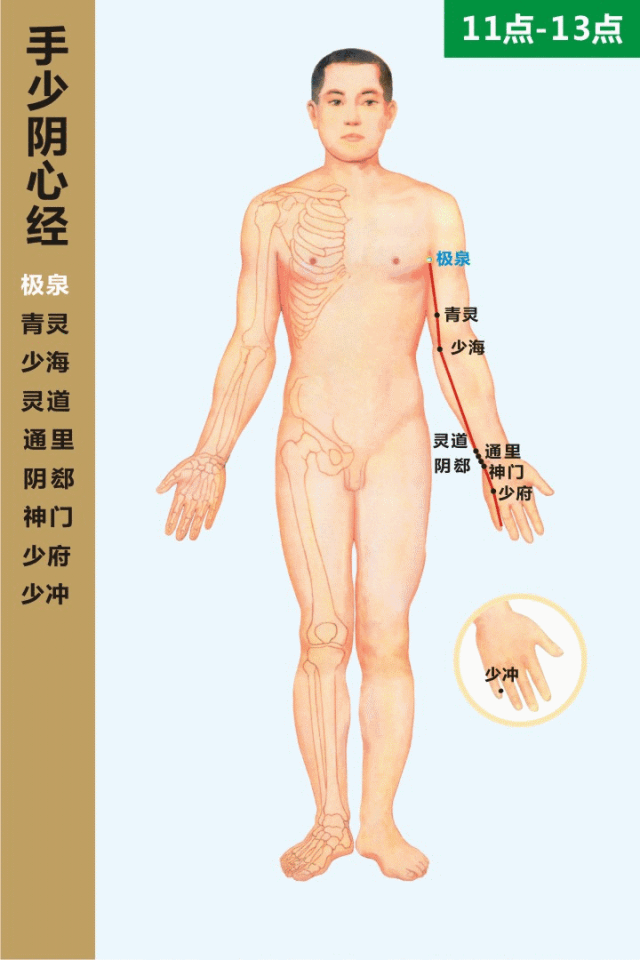 Eliminate the root of all diseases; the heart meridian primarily regulates emotions. Squeeze it 2-3 times daily for 3 minutes each time, and you will feel light and refreshed, preventing excess weight. The heart meridian starts at the Ji Quan point under the armpit and ends at the Shao Chong point on the little finger. The heart meridian can treat primary heart diseases and emotional disorders, such as mental confusion, depression, and excessive sweating in the palms.Acupoints on the Heart Meridian:Ji Quan Point: Can improve throat dryness, restlessness, thirst, lymphatic issues, and regulate heart rhythm. The pericardium meridian treats cardiovascular diseases, while the heart meridian addresses emotional issues.
Eliminate the root of all diseases; the heart meridian primarily regulates emotions. Squeeze it 2-3 times daily for 3 minutes each time, and you will feel light and refreshed, preventing excess weight. The heart meridian starts at the Ji Quan point under the armpit and ends at the Shao Chong point on the little finger. The heart meridian can treat primary heart diseases and emotional disorders, such as mental confusion, depression, and excessive sweating in the palms.Acupoints on the Heart Meridian:Ji Quan Point: Can improve throat dryness, restlessness, thirst, lymphatic issues, and regulate heart rhythm. The pericardium meridian treats cardiovascular diseases, while the heart meridian addresses emotional issues.
8. Small Intestine Meridian
Wei Hour: 13:00——15:00
Small Intestine Meridian: The small intestine meridian adjusts the body’s nutrition during the Wei hour. If there is heat in the small intestine, the body will experience gas. Therefore, lunch should be eaten before 1:00 PM to ensure that nutrients are absorbed into the body.
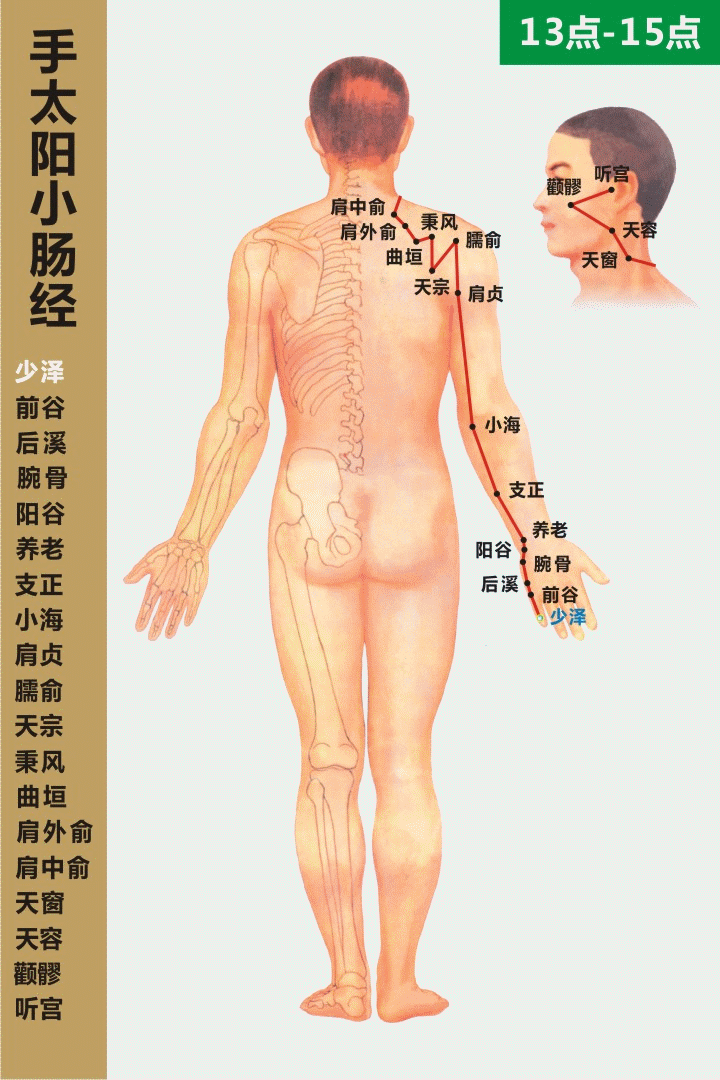 The small intestine primarily governs fluid diseases, and its function is to distinguish clear from turbid, absorbing nutrients from digested food and expelling waste. The small intestine meridian runs from the Shao Ze point on the little finger to the arm, shoulder, and behind the ear, ending at the Ting Gong point, with 19 acupoints along the meridian. Massaging the small intestine meridian can improve shoulder, neck, and cervical spine diseases and enhance blood supply to the brain. Essential oils such as geranium can be used for massage, and all fluid-related diseases, such as menstruation, breast milk, vaginal discharge, semen, and modern medical terms like gastric juice, pancreatic fluid, and prostate fluid, can be addressed by unblocking the small intestine meridian.
The small intestine primarily governs fluid diseases, and its function is to distinguish clear from turbid, absorbing nutrients from digested food and expelling waste. The small intestine meridian runs from the Shao Ze point on the little finger to the arm, shoulder, and behind the ear, ending at the Ting Gong point, with 19 acupoints along the meridian. Massaging the small intestine meridian can improve shoulder, neck, and cervical spine diseases and enhance blood supply to the brain. Essential oils such as geranium can be used for massage, and all fluid-related diseases, such as menstruation, breast milk, vaginal discharge, semen, and modern medical terms like gastric juice, pancreatic fluid, and prostate fluid, can be addressed by unblocking the small intestine meridian.
9. Bladder Meridian
Shen Hour: 15:00——17:00
Bladder Meridian: Urination! The bladder expels water from the body. If there is heat in the bladder, it can lead to bladder cough, which is coughing while urinating. The bladder is most active at this time, so it is advisable to drink more water. Do not hold urine at this time, as it can lead to urinary retention.
 Maintaining a clear and unobstructed detoxification pathway is crucial; it is the body’s most important detoxification channel. Keeping the bladder meridian open ensures a toxin-free body. If you want to reduce back and buttock fat, simply scraping or massaging the bladder meridian on the back is very effective.It expels wind, cold, heat, dampness, dryness, and toxins from the body, achieving the effect of unblocking the hundred meridians and eliminating diseases, particularly effective for modern sub-health and chronic disease regulation, targeting muscle soreness, body aches, and swelling with immediate results.The Three Major Detoxification Pathways of the Human Body:First: The urinary tract, which expels urine, is the largest detoxification pathway in the body.Second: The intestines, which expel waste from the body; actually, expelling toxins through urine is more important for the body because a person can survive for ten days without defecating, but three days without urinating can be dangerous.Third: The pores, which expel toxins through sweating.The bladder meridian controls both urine and sweat pathways, so this meridian must not be blocked. Additionally, the bladder meridian directly connects to the organs, starting from the Jing Ming point in the eyes to the outer side of the little toe and ending at the Yin point.Acupoints on the Bladder Meridian:Qing Ming Point: The primary acupoint for treating eye diseases.Can Zhu Point: Very effective for heat symptoms, such as red and swollen eyes; massaging this point yields immediate results.Tip:1. Use the tips of ten fingers to stimulate the bladder meridian on the head 50 times daily to clear the nose, treat eye diseases, and alleviate headaches and epilepsy.2. Regularly tapping the back and the back of the thighs can aid in weight loss and expel cold from the body, serving as an excellent health maintenance method.
Maintaining a clear and unobstructed detoxification pathway is crucial; it is the body’s most important detoxification channel. Keeping the bladder meridian open ensures a toxin-free body. If you want to reduce back and buttock fat, simply scraping or massaging the bladder meridian on the back is very effective.It expels wind, cold, heat, dampness, dryness, and toxins from the body, achieving the effect of unblocking the hundred meridians and eliminating diseases, particularly effective for modern sub-health and chronic disease regulation, targeting muscle soreness, body aches, and swelling with immediate results.The Three Major Detoxification Pathways of the Human Body:First: The urinary tract, which expels urine, is the largest detoxification pathway in the body.Second: The intestines, which expel waste from the body; actually, expelling toxins through urine is more important for the body because a person can survive for ten days without defecating, but three days without urinating can be dangerous.Third: The pores, which expel toxins through sweating.The bladder meridian controls both urine and sweat pathways, so this meridian must not be blocked. Additionally, the bladder meridian directly connects to the organs, starting from the Jing Ming point in the eyes to the outer side of the little toe and ending at the Yin point.Acupoints on the Bladder Meridian:Qing Ming Point: The primary acupoint for treating eye diseases.Can Zhu Point: Very effective for heat symptoms, such as red and swollen eyes; massaging this point yields immediate results.Tip:1. Use the tips of ten fingers to stimulate the bladder meridian on the head 50 times daily to clear the nose, treat eye diseases, and alleviate headaches and epilepsy.2. Regularly tapping the back and the back of the thighs can aid in weight loss and expel cold from the body, serving as an excellent health maintenance method.
10. Kidney Meridian
You Hour: 17:00——19:00
Kidney Meridian: The kidneys are the essence of reproduction and the essence of the five organs and six bowels. The kidneys are the root of pre-natal essence. After the body’s detoxification during the Shen hour, the kidneys enter the time for storing essence during the You hour. This is a crucial time for men. For those with kidney function issues, massaging the kidney meridian at this time is most effective.
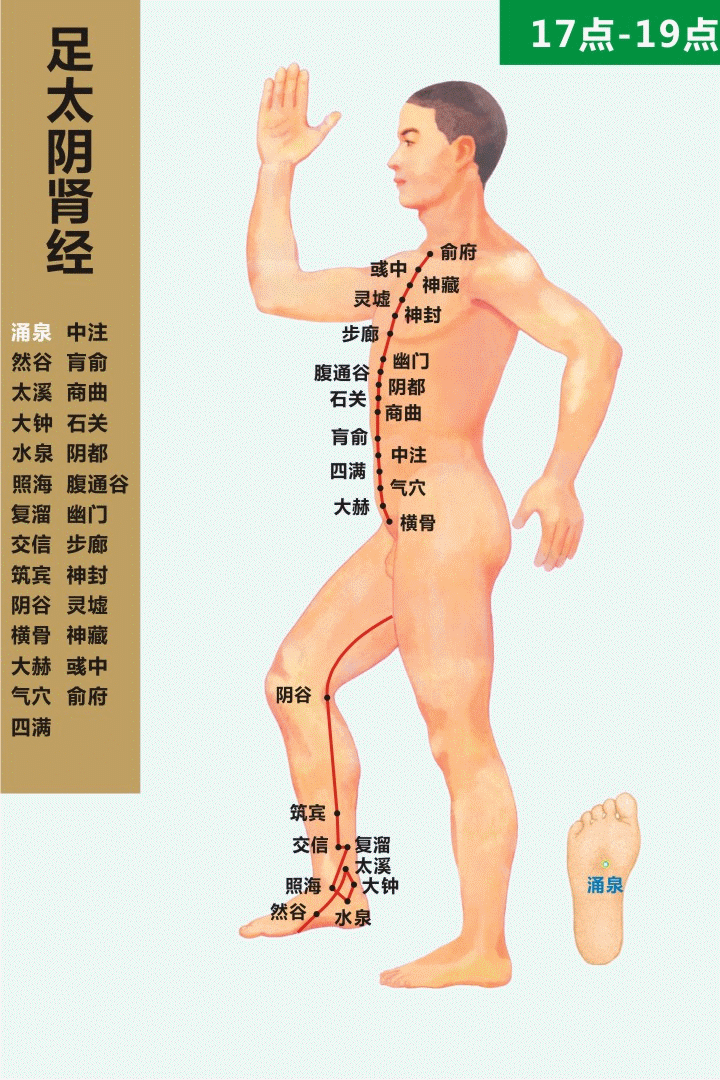 Activate the root of pre-natal essence; fear not disease or aging. The kidney meridian starts from the Yong Quan point and circulates to the head; tonifying the kidneys is a lifelong task. Strong kidney qi prevents aging.Acupoints on the Kidney Meridian:Yong Quan Point: Regular stimulation and massage can prevent aging.Ran Gu Point: Treats diabetes, restlessness, thirst, nocturnal emissions, and if one frequently feels thirsty and anxious, it indicates excessive heart fire; massaging this point can help reduce heart fire.Da Zhong Point: Treats loss of voice and heel pain; acupoints on the kidney meridian can also treat throat diseases, as the kidney meridian connects to the throat.
Activate the root of pre-natal essence; fear not disease or aging. The kidney meridian starts from the Yong Quan point and circulates to the head; tonifying the kidneys is a lifelong task. Strong kidney qi prevents aging.Acupoints on the Kidney Meridian:Yong Quan Point: Regular stimulation and massage can prevent aging.Ran Gu Point: Treats diabetes, restlessness, thirst, nocturnal emissions, and if one frequently feels thirsty and anxious, it indicates excessive heart fire; massaging this point can help reduce heart fire.Da Zhong Point: Treats loss of voice and heel pain; acupoints on the kidney meridian can also treat throat diseases, as the kidney meridian connects to the throat.
11. Pericardium Meridian
Xu Hour: 19:00——21:00
Pericardium Meridian: This moment creates conditions for peaceful sleep and a calm mindset.
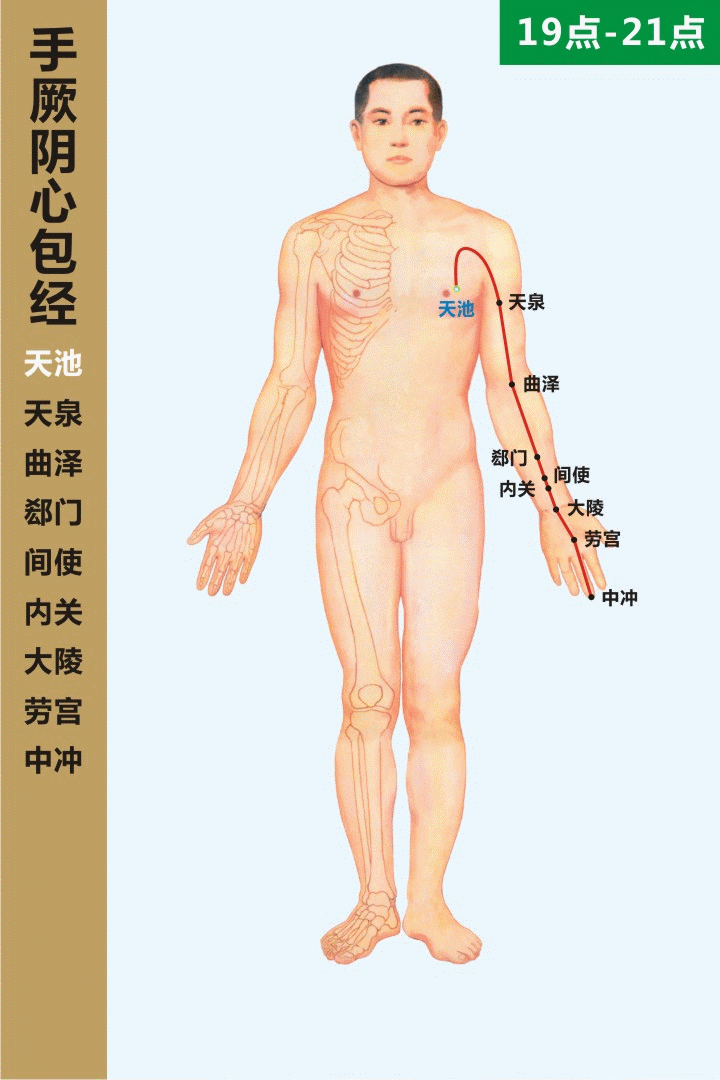 Saving lives, the pericardium meridian can regulate heart function and serves as the heart’s protector. Regularly tapping the pericardium meridian is like adding a double layer of insurance for life. The pericardium meridian runs from the center of the breast to the arm.Acupoints on the Pericardium Meridian:Tian Chi Point: Located one inch beside the nipple, treats breast hyperplasia, mastitis, and other breast system diseases and lymphatic tuberculosis.
Saving lives, the pericardium meridian can regulate heart function and serves as the heart’s protector. Regularly tapping the pericardium meridian is like adding a double layer of insurance for life. The pericardium meridian runs from the center of the breast to the arm.Acupoints on the Pericardium Meridian:Tian Chi Point: Located one inch beside the nipple, treats breast hyperplasia, mastitis, and other breast system diseases and lymphatic tuberculosis.
12. San Jiao Meridian
Hai Hour: 21:00——23:00
San Jiao Meridian: Time to sleep! This is when the body’s largest organ, the San Jiao, operates, overseeing all qi and unblocking water pathways. During the Hai hour, the San Jiao connects all meridians. It is a time for rest and recuperation.
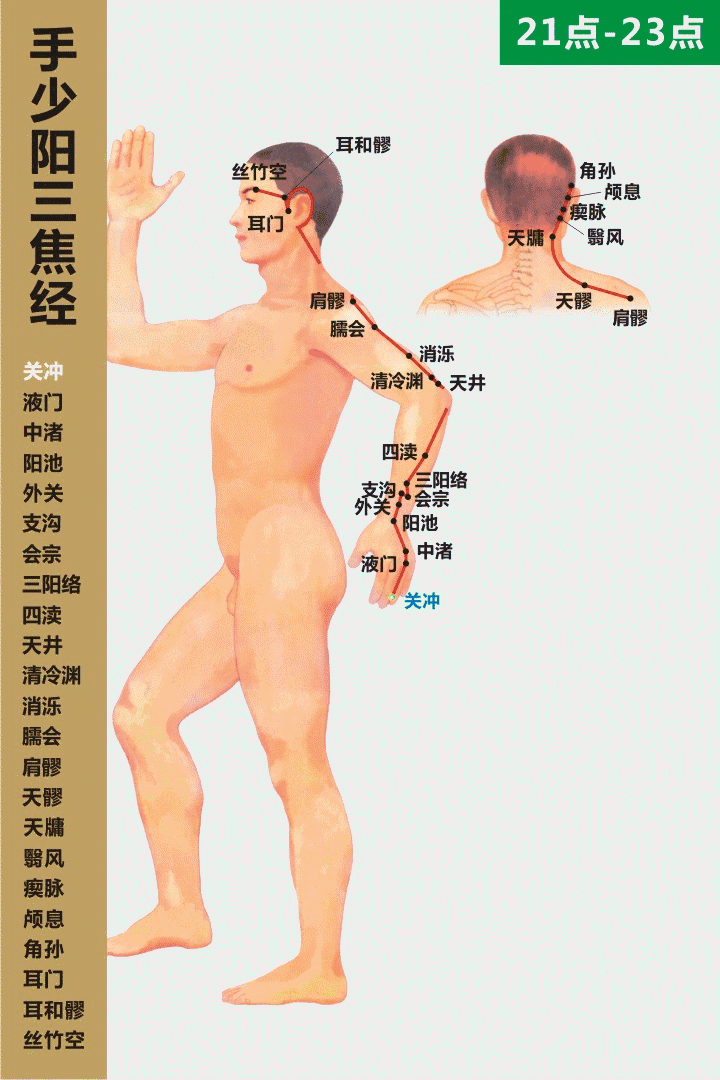 Have you detoxified today? The Hand Shaoyang San Jiao Meridian is one of the best meridians for detoxification, starting from the Guan Chong point on the ring finger and ending at the Si Zhu Kong point on the face, traversing the hand, shoulder, neck, head, and face, with 20 acupoints along the meridian.Blockage of the San Jiao meridian can lead to numbness in the arms, shoulder and neck pain, shoulder periarthritis, throat pain, dry throat, migraines, and wrinkles around the eyes. The circulation time is from 21:00 to 23:00; massaging and tapping during this time can have health benefits. If symptoms of San Jiao blockage arise, essential oils such as eucalyptus, peppermint, and lavender can enhance the massage effects.13. Governing Vessel
Have you detoxified today? The Hand Shaoyang San Jiao Meridian is one of the best meridians for detoxification, starting from the Guan Chong point on the ring finger and ending at the Si Zhu Kong point on the face, traversing the hand, shoulder, neck, head, and face, with 20 acupoints along the meridian.Blockage of the San Jiao meridian can lead to numbness in the arms, shoulder and neck pain, shoulder periarthritis, throat pain, dry throat, migraines, and wrinkles around the eyes. The circulation time is from 21:00 to 23:00; massaging and tapping during this time can have health benefits. If symptoms of San Jiao blockage arise, essential oils such as eucalyptus, peppermint, and lavender can enhance the massage effects.13. Governing Vessel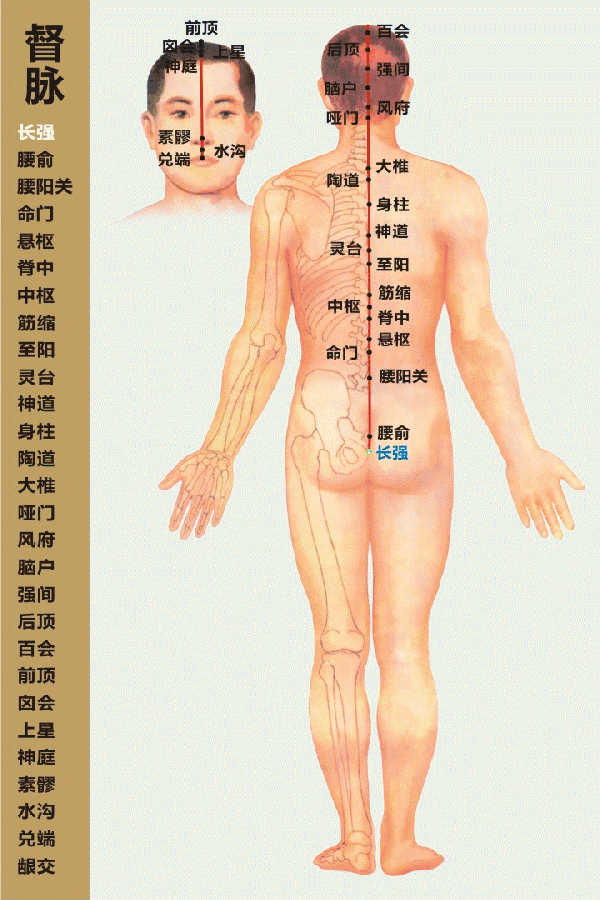 It governs all yang meridians.The place where the sun rises in the human body, the Governing Vessel must be strong to support the body; acupoint:Da Zhui Point: Eliminates heat toxins, resists wind and cold; during colds and fevers, do not take medicine; just use cupping or scraping at this point.14. Conception Vessel
It governs all yang meridians.The place where the sun rises in the human body, the Governing Vessel must be strong to support the body; acupoint:Da Zhui Point: Eliminates heat toxins, resists wind and cold; during colds and fevers, do not take medicine; just use cupping or scraping at this point.14. Conception Vessel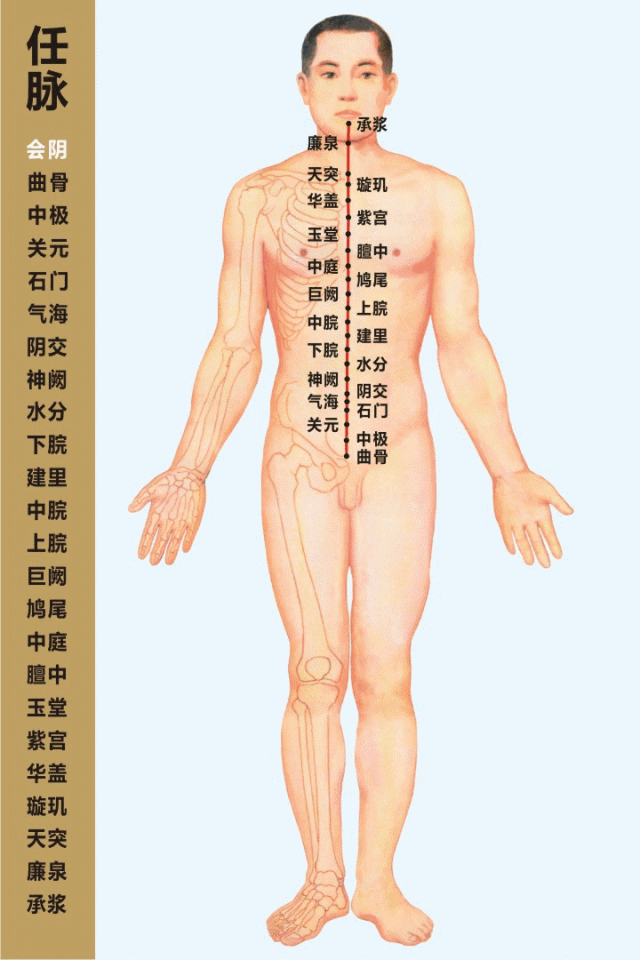 Unblocking the Conception Vessel prevents all toxins. When regulating the Conception Vessel, pay attention to three points:1. Use moxa sticks to fumigate the navel (Shen Que point), which has a great tonifying effect.2. Cupping at the Zhong Wan and below the Qi Hai can help regulate the five organs and six bowels, calming the spirit.3. Regularly push the abdomen and massage the Dan Zhong point.Technique:Kneeling and walking before sleep can stimulate the speed of qi and blood flow, directing qi and blood to the knees. After eating, qi and blood should be concentrated in the stomach; directing it to the knees is not conducive to digestion.Diagnosis through Acupoint Massage:Soreness: The meridian is open, but qi and blood are insufficient; increase qi and blood flow to alleviate soreness. For example, if someone who rarely climbs mountains feels sore after climbing, it indicates insufficient qi and blood; relatively speaking, soreness is a good sign, indicating that the meridian is open but temporarily lacking blood, requiring supplementation.Soreness and Pain: Indicates a lack of blood and some blood stasis; cupping is the best remedy.Distension: Indicates abundant qi, often associated with an irritable constitution; if qi cannot be expelled, it will cause distension. In this case, do not use cupping, as it may worsen the distension.Distension and Pain: Indicates strong fire and irritability, suggesting that there is excess qi but insufficient blood, leading to poor blood distribution.Pain: Indicates blood stasis; cupping is recommended.Summary
Unblocking the Conception Vessel prevents all toxins. When regulating the Conception Vessel, pay attention to three points:1. Use moxa sticks to fumigate the navel (Shen Que point), which has a great tonifying effect.2. Cupping at the Zhong Wan and below the Qi Hai can help regulate the five organs and six bowels, calming the spirit.3. Regularly push the abdomen and massage the Dan Zhong point.Technique:Kneeling and walking before sleep can stimulate the speed of qi and blood flow, directing qi and blood to the knees. After eating, qi and blood should be concentrated in the stomach; directing it to the knees is not conducive to digestion.Diagnosis through Acupoint Massage:Soreness: The meridian is open, but qi and blood are insufficient; increase qi and blood flow to alleviate soreness. For example, if someone who rarely climbs mountains feels sore after climbing, it indicates insufficient qi and blood; relatively speaking, soreness is a good sign, indicating that the meridian is open but temporarily lacking blood, requiring supplementation.Soreness and Pain: Indicates a lack of blood and some blood stasis; cupping is the best remedy.Distension: Indicates abundant qi, often associated with an irritable constitution; if qi cannot be expelled, it will cause distension. In this case, do not use cupping, as it may worsen the distension.Distension and Pain: Indicates strong fire and irritability, suggesting that there is excess qi but insufficient blood, leading to poor blood distribution.Pain: Indicates blood stasis; cupping is recommended.Summary
The basic spirit and main content of the Huangdi Neijing include: holistic concepts, Yin-Yang and Five Elements, organ systems, pathogenesis, diagnostic methods and treatment principles, preventive health, and the theory of Five Movements and Six Qi, etc.
The “holistic concept” emphasizes that the human body and nature are an integrated whole, and that the structure and various parts of the body are interconnected.
The “Yin-Yang and Five Elements” theory explains the relationship of opposition and unity between things. The “organ systems” focus on the physiological functions, pathological changes, and interrelationships of the five organs and six bowels, twelve meridians, and eight extraordinary meridians. The “pathogenesis” discusses the internal mechanisms of disease occurrence and changes after various pathogenic factors act on the human body.
The “diagnostic methods and treatment principles” are the fundamental principles of TCM for understanding and treating diseases.
The “preventive health” systematically elaborates on TCM’s theories of health preservation based on time and place, summarizing important experiences in disease prevention.
The “theory of movements and qi” studies the impact of natural climate on human physiology and pathology, using this as a basis to guide people in seeking benefits and avoiding harm.
Copyright Statement: We emphasize sharing; the images and texts are sourced from the internet, and the copyright belongs to the original author. If there is any infringement, please inform us, and we will promptly delete and apologize.
Click the text below to learn more exciting content:
Fermented Chinese Medicine - A New Chapter in Inheriting Chinese Medicine Culture
Promoting Traditional Chinese Medicine Culture for the Health of the People
Intangible Cultural Heritage - Non-Heritage Herbal Pathways
Non-Heritage Herbal Pathways: Usage, Applicable Groups, and Precautions
Comparative Advantages of Non-Heritage Herbal Pathways, Massage, Moxibustion, and Cupping
Analysis: Eastern Pharmacist Movement Therapy